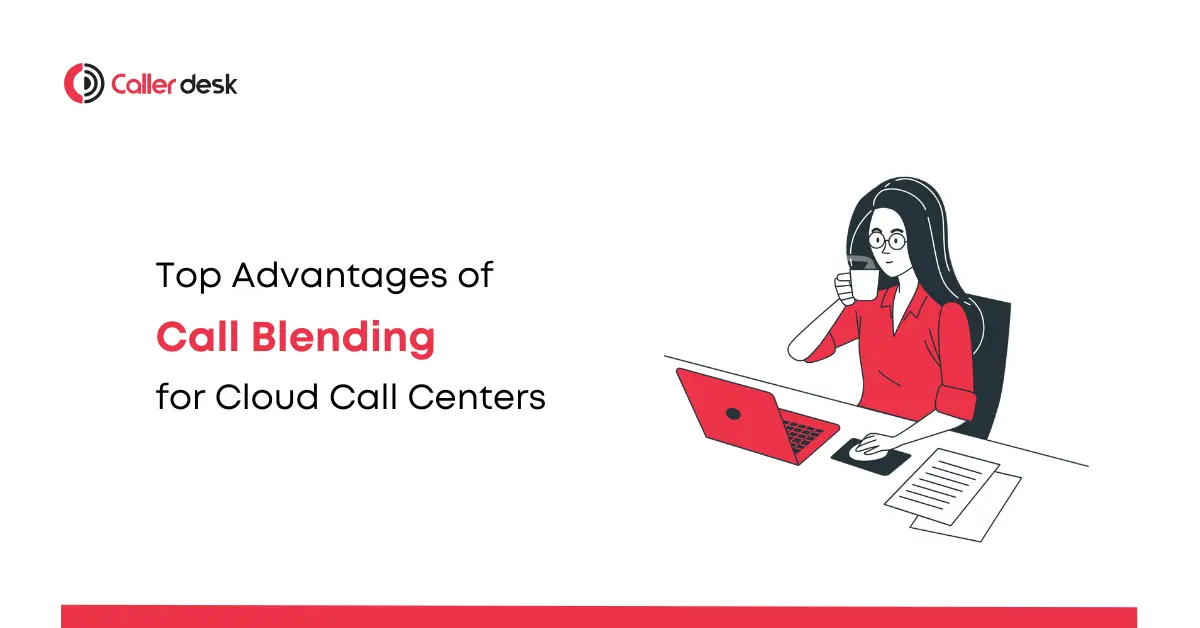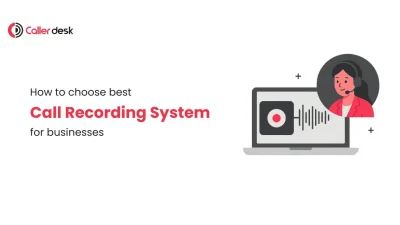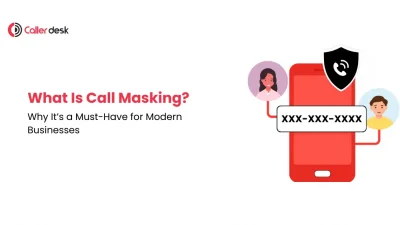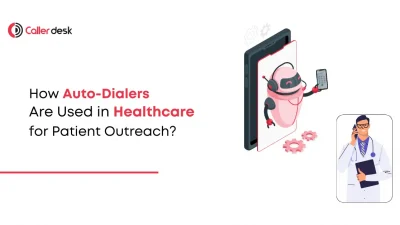Providing exceptional customer service while maintaining operational efficiency is a significant challenge for modern businesses. Cloud call centers have emerged as a transformative solution, enabling businesses to streamline communication and improve service delivery. Among their many features, call blending stands out as a critical tool for optimizing call center operations.
Call blending empowers agents to manage both inbound calls (customer queries, complaints, or support needs) and outbound calls (sales pitches, follow-ups, or surveys) seamlessly. By dynamically allocating tasks based on real-time demand, call blending ensures that agents remain productive, customers receive timely assistance, and business objectives are met efficiently.
This blog explores the key advantages of call blending, discusses potential challenges, and highlights why CallerDesk’s call blending solutions are an essential asset for businesses striving to succeed in today’s competitive landscape.
What is Call Blending?
Call blending is a dynamic system that integrates inbound and outbound call management within a single workflow. It allows call center agents to transition smoothly between tasks based on current call volumes and operational requirements.
How Call Blending Works:
- Dynamic Allocation:
The system monitors real-time call volume. If inbound traffic increases, agents shift to answering customer queries. When inbound volume drops, they switch to outbound activities like sales calls or follow-ups. - Real-Time Monitoring:
Advanced analytics track agent availability and call demand, ensuring efficient task distribution. - Seamless Integration:
Call blending integrates with CRM systems, ticketing platforms, and analytics tools, providing agents with the data they need to deliver personalized service and close deals.
Key Advantages of Call Blending for Cloud Call Centers
1. Enhanced Efficiency
Efficiency is the backbone of any successful call center. Call blending eliminates idle time by dynamically assigning tasks, ensuring agents are always productive.
- Optimized Resource Utilization: No agent remains idle during slow periods.
- Real-Time Adjustments: Respond to fluctuating call volumes seamlessly, preventing bottlenecks.
Example: A healthcare call center experiencing a surge in appointment queries can redirect agents handling outbound reminders to manage the inbound spike, ensuring patients aren’t left waiting.
2. Increased Productivity
By keeping agents consistently engaged, call blending maximizes productivity without additional staffing. Features like automated call distribution route calls efficiently, reducing delays and ensuring agents focus on high-priority tasks.
- Streamlined Workflow: Agents handle more calls per shift with minimal downtime.
- Faster Issue Resolution: Quicker call routing and access to customer data allow agents to resolve issues faster.
3. Improved Customer Satisfaction
Customer satisfaction is at the heart of every successful business. Call blending ensures customers receive prompt, personalized, and high-quality service.
- Faster Response Times: Reduced wait times make customers feel valued and appreciated.
- Proactive Communication: Follow-up calls and reminders demonstrate a commitment to customer care.
Insight: Businesses with faster response times and personalized communication see up to a 25% increase in customer retention rates.
4. Enhanced Employee Engagement
Monotony is a common challenge for call center agents, leading to burnout and reduced morale. Call blending introduces variety into their daily tasks, keeping them engaged and motivated.
- Skill Diversification: Cross-training in inbound and outbound tasks enhances agent capabilities.
- Reduced Burnout: Alternating between tasks prevents monotony and keeps work interesting.
Statistic: Companies that focus on employee engagement experience 41% lower absenteeism and 17% higher productivity.
5. Revenue Growth Opportunities
Call blending creates opportunities for upselling, cross-selling, and lead conversion by combining customer service with sales initiatives.
- Increased Sales Potential: Agents can offer complementary products during support calls.
- Broader Reach: Outbound calls during low inbound periods ensure consistent revenue generation.
Example: A telecom company uses call blending to promote premium plans during inbound support calls, driving additional revenue while resolving customer issues.
6. Real-Time Insights for Strategic Planning
Data-driven decision-making is crucial for staying competitive. Call blending solutions provide real-time insights into agent performance, call trends, and customer preferences.
- Enhanced Reporting: Managers can track metrics like call resolution times and agent productivity.
- Proactive Adjustments: Use historical data to forecast demand and adjust staffing levels proactively.
7. Ethical Considerations in Call Blending
While call blending offers numerous benefits, ethical practices must guide its implementation to maintain trust and compliance.
- Privacy and Consent: Ensure outbound calls respect customer privacy and adhere to regulations like GDPR and TCPA.
- Transparency: Inform customers about call purposes to avoid misunderstandings.
CallerDesk’s Commitment: CallerDesk prioritizes ethical communication, offering tools to ensure compliance with global data protection standards.
Overcoming Challenges of Call Blending
1. Skill Gaps:
Agents may require additional training to excel in both inbound and outbound tasks.
Solution: CallerDesk offers in-app training modules and mentorship programs to upskill agents effectively.
2. Workflow Interruptions:
Frequent task switching can disrupt agent focus and efficiency.
Solution: CallerDesk minimizes disruptions with intelligent call routing and real-time optimization tools.
Why Choose CallerDesk for Call Blending?
CallerDesk offers industry-leading solutions to help businesses harness the full potential of call blending.
Key Features of CallerDesk’s Call Blending Solutions:
- Dynamic Task Allocation: Adjusts agent tasks in real time for maximum productivity.
- Omnichannel Integration: Manage calls, emails, chats, and social media interactions seamlessly.
- Advanced Analytics: Track key metrics to improve decision-making and service quality.
- Scalability: Easily expand operations to meet growing business demands.
- Ethical Communication: Adheres to global standards for privacy and data security.
Customer Success Story: “CallerDesk helped us reduce wait times by 30% while increasing agent productivity by 25%. Their call blending feature is a game-changer!” – Operations Manager, E-commerce Business.
Conclusion
Call blending is a game-changing feature for cloud call centers, enabling businesses to optimize resources, enhance customer satisfaction, and drive revenue growth. By seamlessly integrating inbound and outbound call management, call blending ensures agents remain productive, customers receive prompt service, and businesses achieve their goals.
With CallerDesk’s advanced call blending solutions, businesses can streamline operations, maintain ethical communication practices, and deliver exceptional customer experiences.
Ready to transform your call center operations? Schedule a free demo with CallerDesk today and experience the power of call blending firsthand.
Frequently asked questions
1. What is call blending in cloud call centers?
Call blending is a system that allows call center agents to handle both inbound and outbound calls seamlessly. It uses real-time data to dynamically allocate tasks based on call volume, ensuring optimal resource utilization and improved productivity.
2. How does call blending improve efficiency?
Call blending reduces idle time by keeping agents engaged in productive tasks, whether handling incoming queries or making outbound sales calls. This maximizes resource utilization and ensures smoother operations.
3. Can call blending improve customer satisfaction?
Yes, call blending improves customer satisfaction by reducing wait times and ensuring timely, personalized responses. Agents can switch between tasks dynamically, providing consistent and high-quality service.
4. What are the challenges of implementing call blending?
Challenges include managing agent skill gaps, maintaining focus during task switches, and ensuring proper workflow management. These can be mitigated with training, intelligent call routing, and effective tools like CallerDesk.
5. What features should I look for in call blending software?
Key features include smart call routing, real-time analytics, omnichannel integration, scalability, and compliance with data protection regulations. CallerDesk offers all these features to optimize call center operations.
6. Is call blending suitable for small businesses?
Yes, call blending is highly scalable and can be tailored to businesses of all sizes. Small businesses can benefit from increased efficiency, improved customer experiences, and cost savings.
7. How does CallerDesk support call blending?
CallerDesk provides advanced call blending solutions, including dynamic task allocation, real-time analytics, omnichannel support, and seamless CRM integration, ensuring efficient and ethical communication practices.
8. Can call blending increase revenue?
Absolutely. Call blending enables agents to upsell, cross-sell, and follow up with potential leads during downtime, creating additional revenue opportunities while maintaining excellent customer service.
9. Is call blending ethically compliant?
Yes, when implemented with proper guidelines, call blending is ethically compliant. CallerDesk ensures adherence to global standards for data privacy and communication ethics, safeguarding customer trust.
10. Why should I choose CallerDesk for call blending?
CallerDesk offers industry-leading features like dynamic call routing, omnichannel support, scalability, and compliance with privacy regulations, making it the ideal solution for businesses seeking efficient and ethical call blending.





